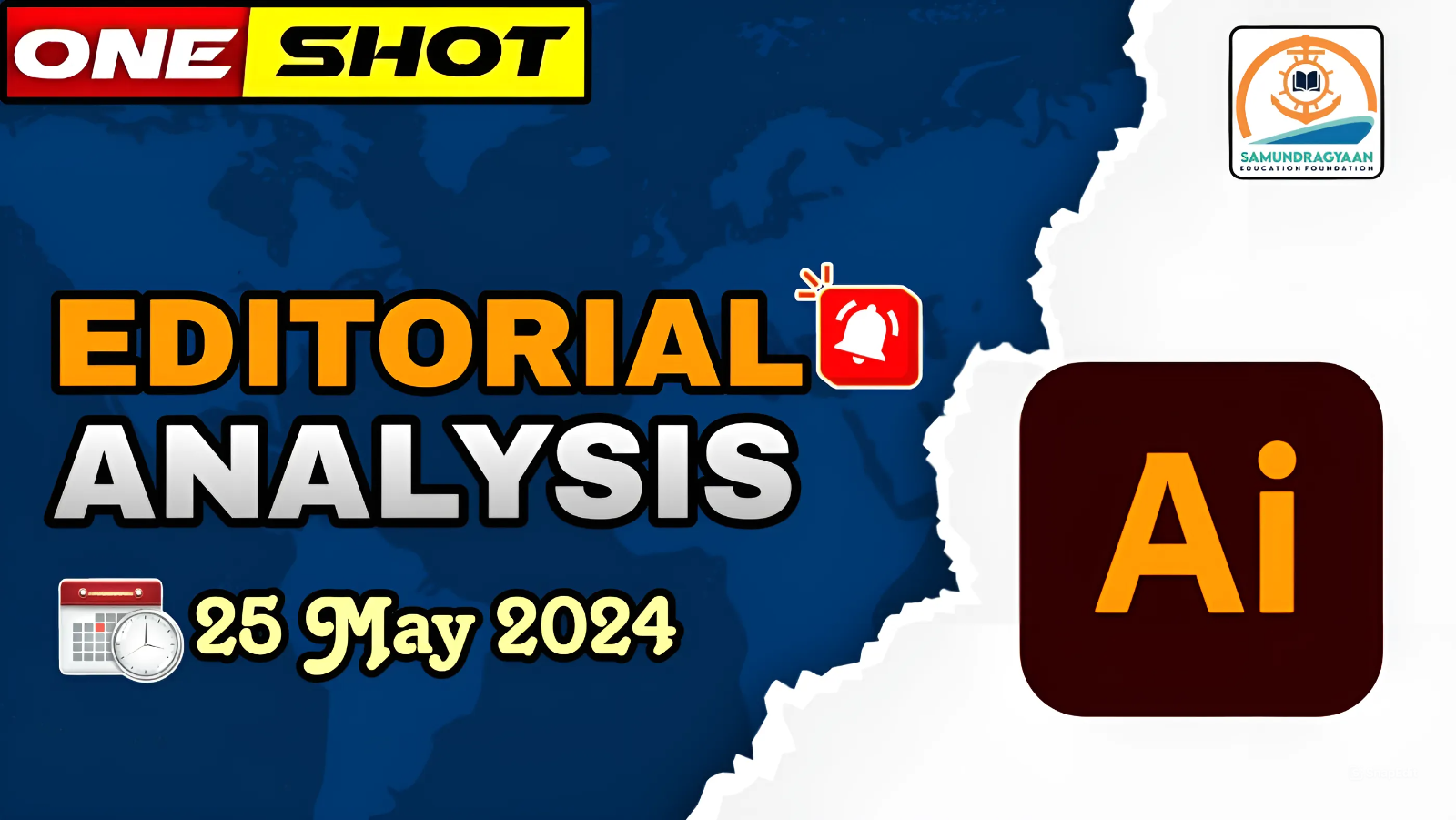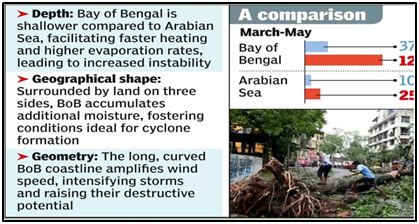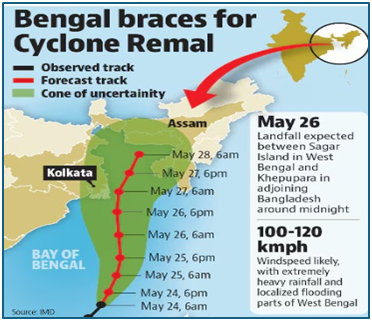Editorials & Articles : 25 May 2024
Cyclone Remal and its landfall

Why in news?
- Cyclonic storm “Remal”, originating in the central Bay of Bengal, is expected to escalate into a severe cyclonic storm by May 25. As per the IMD, the cyclone is expected to make landfall between Sagar Island in West Bengal and Khepupara in Bangladesh around the midnight of May 26.
What’s in today’s article?
- Cyclone
- Landfall of a cyclone
- Bay of Bengal: a cyclone hotspot
- Cyclone management – Steps taken by India
- Cyclone Remal
Cyclone
- About
- A cyclone is a large-scale system of air that rotates around the centre of a low-pressure area. It is usually accompanied by violent storms and bad weather.
- It is characterised by inward spiralling winds that rotate anticlockwise in the Northern Hemisphere and clockwise in the Southern Hemisphere.
- Characteristics of a Tropical Cyclone:
- The centre of a cyclone is very calm and clear with very low air pressure. The average speed is 120 kmph.
- They have closed isobars which leads to greater velocity.
-
-
- Isobars are imaginary lines on a weather map that connect locations with equal atmospheric pressure.
- They develop over oceans and sea only. They are seasonal in nature.
- They move from east to west under the influence of trade winds.
-
- Classification of cyclones
- Cyclones are classified on the basis of wind speed by the Indian Meteorological Department (IMD):
-
-
- Depression: Wind speeds of between 31–49 km/h
- Deep Depression: Between 50-61 km/h
- Cyclonic Storm: Between 62–88 km/h
- Severe Cyclonic Storm: Between 89-117 Km/h
- Very Severe Cyclonic Storm: Between 118-166 Km/h
- Extremely Severe Cyclonic Storm: Between 167-221 Km/h
- Super Cyclonic Storm: Above 222 Km/h
-
Landfall of a cyclone
- Landfall is the event of a tropical cyclone coming onto land after being over water.
- As per the IMD, a tropical cyclone is said to have made a landfall when the center of the storm – or its eye – moves over the coast.
- The “eye” of a cyclone is a region of relatively calm weather found at the center of the storm.
- It is a circular or oval-shaped area characterized by light winds, clear or partly cloudy skies, and decreased precipitation.
- Within the eye, winds are light and variable, often with clear or only partially cloudy skies.
- The size of the eye can vary significantly, ranging from a few kilometers to over 50 kilometers (30 miles) in diameter in larger cyclones.
- During landfall, the outer bands of the storm may have already reached the coast, bringing strong winds, heavy rain, and storm surge.
- A landfall should not be confused with a ‘direct hit’, which refers to a situation where the core of high winds (or eyewall) comes onshore but the centre of the storm may stay remain offshore.
Bay of Bengal: a cyclone hotspot
- Historical data underscore Bay of Bengal’s predisposition to cyclones, with approximately 58% of them making landfall on India’s eastern coast, compared to just 25% in the Arabian Sea.
- The Arabian Sea gets fewer cyclones due to its narrower and deeper nature, cooler water and higher salinity. Its partially landlocked geography also contributes to reduced cyclonic activity.
Cyclone management – Steps taken by India
- National Cyclone Risk Mitigation Project (NCRMP):
- Launched by the MHA, this project aims to reduce the vulnerability of coastal communities and infrastructure to cyclones and storm surges.
- It focuses on capacity building, early warning systems, cyclone shelters, evacuation planning, and community awareness.
- IMD’s Colour Coding of Cyclones: Four colours – Green, Yellow, Orange, and Red – are used by IMD to make people aware about the severity of cyclones.
- Integrated Coastal Zone Management (ICZM) Project
- Coastal Regulation Zones (CRZ)
- Other general steps taken:
- National Disaster Response Force (NDRF)
- National Disaster Management Plan (NDMP)
- National Institute of Disaster Management (NIDM)
- State Disaster Management Authorities (SDMAs)
Cyclone Remal
- Coordination efforts are underway
- To ensure the safety of maritime traffic, the Coast Guard’s remote operating stations at Haldia and Paradip are broadcasting regular and multilingual VHF (very high frequency) alerts.
- Merchant vessels at anchorages have been alerted, and port authorities have been advised to take appropriate actions.
- Nine disaster relief teams have been positioned at strategic locations, including Haldia, Paradip, Gopalpur, and Frazerganj.
- Fishing activities have been banned.
- West Bengal has a high adaptive capacity against cyclones because of cyclone multi-hazard Early Warning Systems (EWS).
- EWS is made available under the National Cyclone Risk Mitigation Project (NCRMP) Phase II.
- The state’s high tele-density ratio allows people to access early warnings via telephone or mobile.
Reservations cannot be Granted Solely on the Basis of Religion
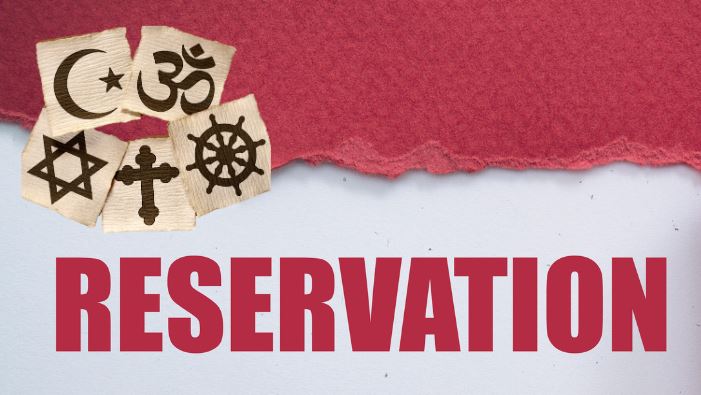
Why in News?
- A series of orders passed by the West Bengal government, giving reservation to 77 communities/classes (75 of which were Muslim) under the Other Backward Classes (OBC) category, has been quashed by the Calcutta High Court (HC).
- However, the court observed that those who got employment using the certificates and were already in service through such reservation would not be affected by the order.
- The ruling from the HC coincides with the midst of an election campaign where Muslim reservations have been a contentious topic.
What’s in Today’s Article?
- The Orders Passed by the WB Govt to Grant Reservation on the Basis of Religion
- The Orders Challenged in the Calcutta HC
- What was the Ruling Given by the Calcutta HC?
- What is said Regarding Religiously-Based Reservations in the Constitution and Court Orders?
The Orders Passed by the WB Govt to Grant Reservation on the Basis of Religion:
- In 2010, the WB government issued notifications (on the recommendations of the West Bengal Backward Classes Commission), including 42 classes (of which 41 were from the Muslim community) as OBCs.
- Also, the notifications entitled them to reservation and representation in Government Employment under Article 16(4) of the Constitution.
- In the same year, an order was issued sub-categorising the 108 identified OBCs in the state (66 pre-existing and 42 newly identified) into 56 OBC-A (more Backward) and 52 OBC-B (Backward) categories.
- In 2012, the WB government included 35 classes (of which 34 were from the Muslim community) as OBCs.
- In 2013, the West Bengal Backward Classes (Other than Scheduled Castes and Scheduled Tribes) (Reservation of vacancies and posts) Act 2012 gave recognition to all 77 new OBCs.
The Orders Challenged in the Calcutta HC:
- The above orders/ legislation of the WB govt was challenged in the HC on the grounds that –
- The declaration of classes as OBCs was based purely on religion.
- The categorisation is not based on any acceptable data.
- The survey conducted by the Commission was unscientific.
What was the Ruling Given by the Calcutta HC?
- The court found that religion had been the sole basis for the state government to provide reservation, which is prohibited by the Constitution and court orders.
- The HC relied heavily on the Supreme Court’s judgment in Indra Sawhney v Union of India (Mandal judgment).
- In 1992, a nine-judge Bench held that OBCs cannot be identified and given reservation only on the basis of religion.
- The SC also held that all states must establish a Backward Classes Commission to identify and recommend classes of citizens for inclusion and exclusion in the state OBC list.
- The HC noted that the Commission’s recommendation had been made with “lightning speed” and without using any “objective criteria” to determine the backwardness of these classes.
- There is no question in this court’s mind that the said communities have been used as a political prop for vote banks politics.
- The court also struck down some provisions of WB’s 2012 Act, including
- The provision that allowed the state government to sub-classify OBC reservations into OBC-A and OBC-B categories, and
- The provision allowing the state to amend the Schedule of the 2012 Act to add to the list of OBCs.
- The court held that sub-classification is meant to address the different levels of deprivation faced by different communities and could only be done on the basis of scientific data.
- Since the Commission acknowledged that the govt did not consult it prior to sub-classification within OBC, the court ruled that the state govt must consult the Commission for creating a fair and unbiased classification.
What is said Regarding Religiously-Based Reservations in the Constitution and Court Orders?
- The Constitution of India:
- Article 15 (1) specifically prohibits the state from discriminating against citizens on grounds only of both religion and caste (along with sex, race, and place of birth).
- Article 16 (2) specifically prohibits the state from discriminating against citizens on grounds only of religion, race, caste, sex, descent, place of birth, residence or any of them, in respect of any employment or office under the State.
- The Observations of SC:
- In M R Balaji (1962), the SC held that while castes among Hindus may be an important factor to take into account when assessing the social backwardness of certain groups or classes of citizens, it cannot be the only test in this regard.
- In the E P Royappa vs State Of Tamil Nadu (1973), the SC has held that equality is a dynamic concept and cannot be confined within traditional limits.
- In the State of Kerala vs N M Thomas (1975), the SC held that the crucial word ‘only’ in Articles 15 and 16 implies that –
- If a religious, racial, or caste group constitutes a weaker section (under Article 46) or constitutes a backward class,
- It would be entitled to special provisions for its advancement.
- The SC in Indra Sawhney (1992) laid down that any social group, if found to be backward under the same criteria as others, will be entitled to be treated as a backward class.
AI agents
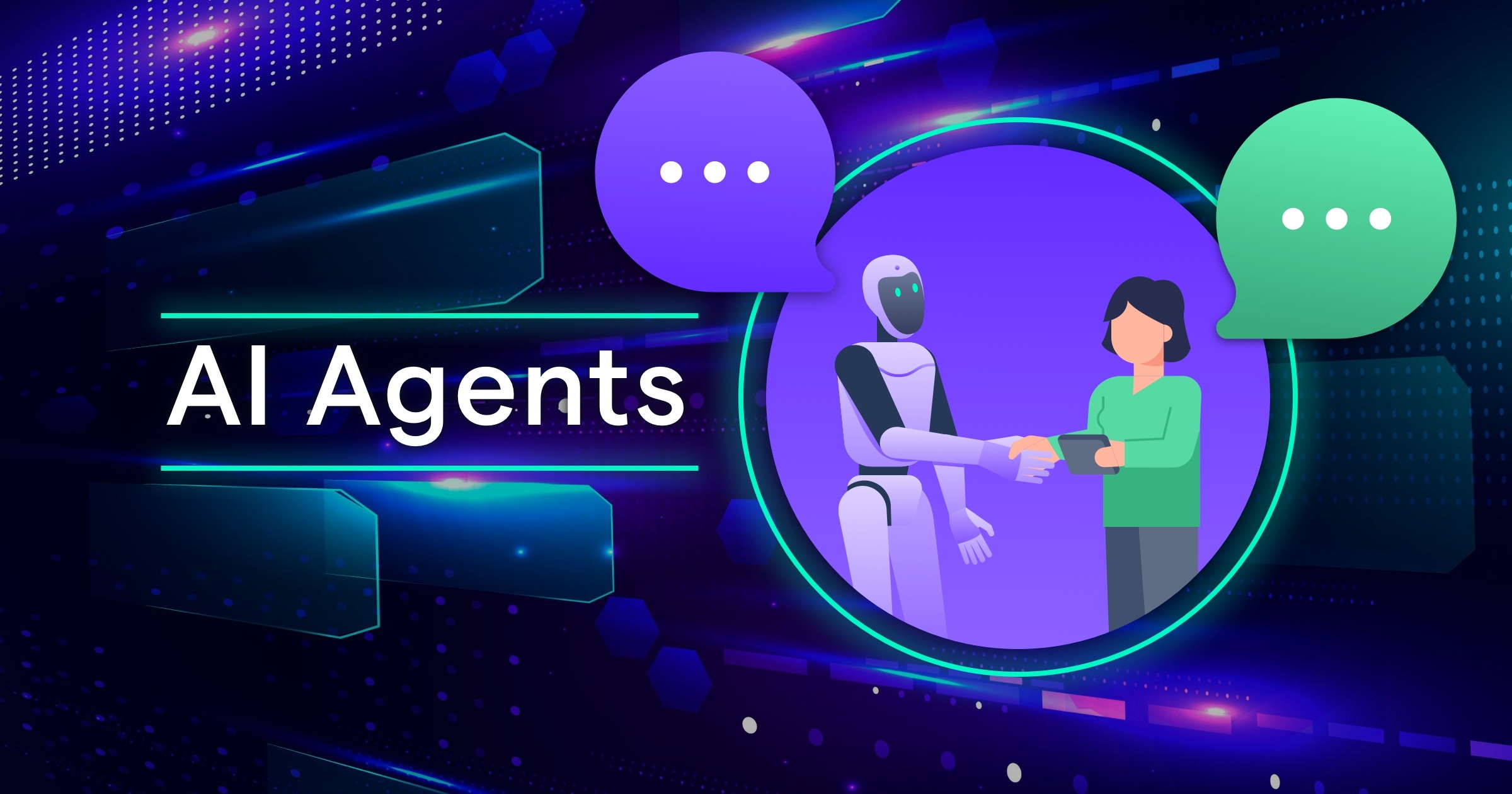
Why in news?
- OpenAI’s GPT-4o and Google’s Project Astra are new AI models that can process real-world audio and visual inputs for intelligent, real-time conversations. These “AI agents” are more advanced than traditional voice assistants like Alexa and Siri, marking a shift from chatbots to interactive AI agents.
What’s in today’s article?
- AI Agents
- LLM
- LLM Vs AI Agents
AI Agents
- About
- AI agents are advanced systems capable of real-time interactions using text, voice, and images.
- Unlike traditional models that only handle text, AI agents can process diverse inputs from their surroundings and respond accordingly.
- AI agents are nimble when it comes to adapting to new situations. This facet makes them incredibly versatile and capable of handling a wide range of situations.
- Working
- AI agents perceive their environment via sensors, then process the information using algorithms or AI models, and subsequently, take actions.
- Currently, they are used in fields such as gaming, robotics, virtual assistants, autonomous vehicles, etc.
- Potential uses of AI agents
- Intelligent Assistants
- AI agents can serve as intelligent and highly capable assistants, handling tasks like offering personalized recommendations and scheduling appointments.
- They are ideal for customer service due to their ability to offer seamless, natural interactions and resolve queries instantly without human intervention.
- Education and Training
- AI agents can act as personal tutors, customizing themselves based on a student’s learning style and offering tailored instructions.
- Healthcare Support
- AI agents can assist medical professionals by providing real-time analysis, diagnostic support, and patient monitoring.
- Intelligent Assistants
- Risks and challenges
- Privacy and security are a key area of concern as AI agents gain access to more personal data and environmental information.
- Just like any AI model, AI agents can carry forward biases from their training data or algorithms, leading to harmful outcomes.
Large Language Models (LLMs)
- LLMs use deep learning techniques to process large amounts of text.
- They work by processing vast amounts of text, understanding the structure and meaning, and learning from it.
- LLMs are trained to identify meanings and relationships between words.
- The greater the amount of training data a model is fed, the smarter it gets at understanding and producing text.
- The training data is usually large datasets, such as Wikipedia, OpenWebText, and the Common Crawl Corpus.
LLMs Vs. AI Agents
- Enhanced Interactions
- While LLMs like GPT-3 and GPT-4 generate human-like text, AI agents enhance interactions using voice, vision, and environmental sensors, making them more natural and immersive.
- Real-Time Conversations
- Unlike LLMs, AI agents are designed for instantaneous, real-time conversations with responses much similar to humans.
- Contextual Understanding
- AI agents understand and learn from the context of interactions, providing more relevant and personalized responses compared to LLMs.
- Autonomous Capabilities
- Unlike LLMs, AI agents can perform complex tasks autonomously, such as coding and data analysis.
- When integrated with robotic systems, they can even perform physical actions.

